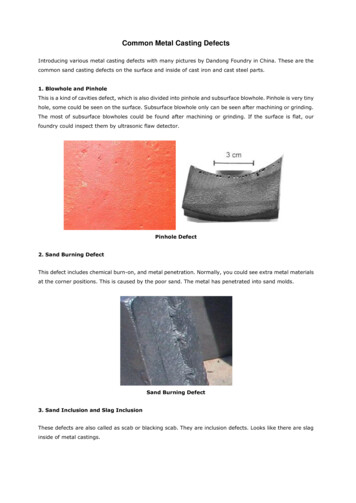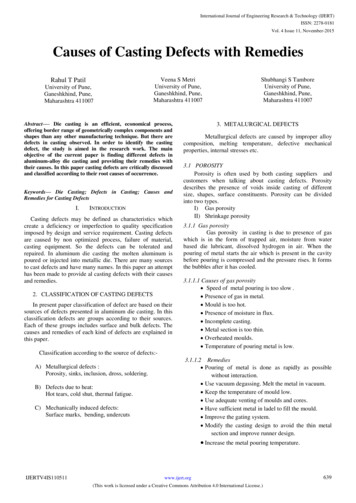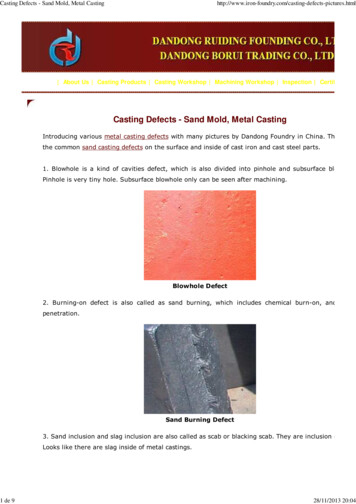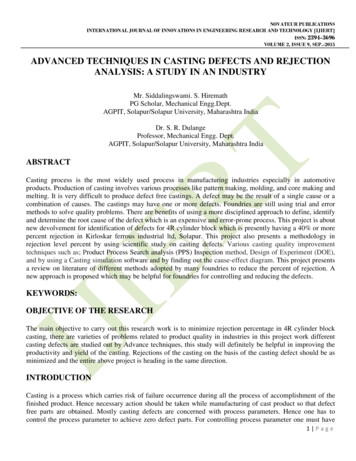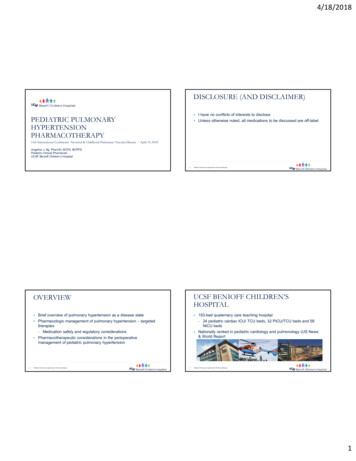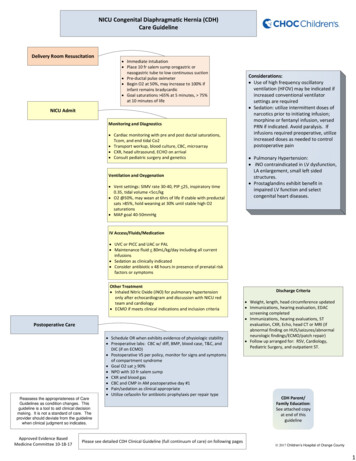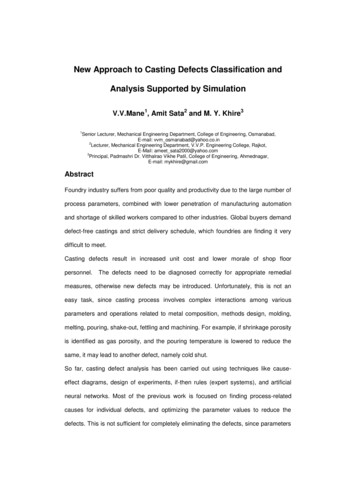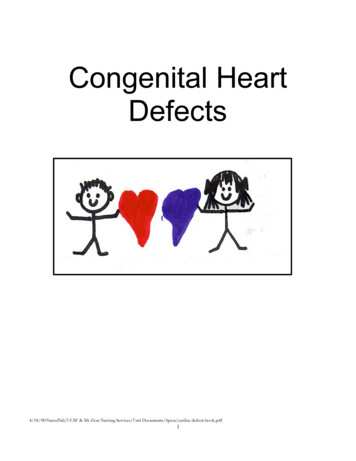
Transcription
Congenital HeartDefects4/18/00:NursePub/UCSF & Mt Zion Nursing Services/Unit Documents/6picu/cardiac defects book.pdf1
Congenital Heart DefectsCHD with Increased Pulmonary Blood FlowPatent Ductus Arteriosus - PDA .3Atrial Septal Defect - ASD. 4Ventricular Septal Defect - VSD .5Aorto-Pulmonary Window . 6Truncus Arteriosus . 8D-Transposition of the Great Arteries. 9Partial or Total Anomalous Pulmonary Venous Return P-APVR/T-APVR . 10CHD with Decreased Pulmonary Blood FlowPulmonary Stenosis . 12Tetrology of Fallot . 13Tetrology of Fallot with Pulmonary Atresia . 14Tetrology of Fallot with Pulmonary Atresia & Major Aorto-Pulmonary Collateral’s (MAPCA’S). 15Tricuspid Atresia . 18Double Outlet Right Ventricle - DORV. 19CHD with Decreased Systemic Blood FlowCoarctation of the Aorta. 22Interrupted Aortic Arch. 23Aortic Stenosis. 24Hypoplastic Left Heart Syndrome . 25Ebstein’s Anomaly. 26Palliative ProceduresPulmonary Artery Banding . 27Blalock-Taussig Shunt. 28Bi-directional Glenn Shunt . 29Norwood. 31Corrective RepairRastelli . 32Damus-Kaye-Stansel. 32Fontan. 33Mustard . 34Senning. 34Rashkind Balloon Septostomy. 34Atrial Septectomy. 34Ross Procedure . 35Konno Procedure . 35Congenital Cardiac ConditionsL-Transposition of the Great Arteries . 36Anomalous Coronary Artery. 37Cardiac Malposition. 38Heterotaxy. 38Shones Complex. 38Syndromes . 39Hereditary Syndrome Cardiac Defect Clinical Features. 39Non-Hereditary Syndromes Associated with. 40Cardiovascular Anomalies . 40SyndromeCardiac Defect Clinical Features . 404/18/00:NursePub/UCSF & Mt Zion Nursing Services/Unit Documents/6picu/cardiac defects book.pdf2
Patent Ductus Arteriosus - PDAAnatomyThe ductus arteriosus is a communication between the pulmonary artery and the aortic arch distal to the leftsubclavian artery. Patent ductus arteriosus (PDA) is the failure of the fetal ductus arteriosus to close afterbirth.PhysiologyLeft to right shunting of blood through the patent ductus results in an increase in pulmonary blood flow. Theamount of blood that flows through the ductus, and the degree of symptoms exhibited, is determined by thedifferences in systemic and pulmonary vascular resistance, and in the circumference and the length of thePDA.NOTE: The PDA may be life-saving in infants with complex cyanotic heart defects or left sided obstructivedefects, providing the only or major source of pulmonary or systemic blood flow. A continuous PGEinfusion will maintain the ductal opening and sustain life until cardiac surgery can be performed. PDA’smay be present in premature infants.PreopThe small or premature infant with a PDA is at risk for CHF, which may be treated with diuretics and/ordigitalization. Surgical correction is recommended for all infants with CHF who have not responded tomedical management, and for any child greater than 1 year of age. Prolonged left to right shunting can resultin pulmonary vascular disease.SurgerySurgery is accomplished via a left thoracotomy incision and without the use of cardiopulmonary bypass. Theductus may be ligated (tied) or divided (cut) and sewn. The timing of surgery depends on the severity ofsymptoms and the size of the defect. Some PDA’s can be closed nonsurgically with coil placement viacardiac catheterization.PostopComplications are rare. In the premature infant, other factors such as respiratory distress complicaterecovery.4/18/00:NursePub/UCSF & Mt Zion Nursing Services/Unit Documents/6picu/cardiac defects book.pdf3
Atrial Septal Defect - ASDAnatomyAn atrial septal defect (ASD) is a communication or opening between the atria that results in shunting ofblood between the two chambers. There are 4 anatomic types:Ostium primum - low in atrial septum, may involve a cleft mitral valve.Ostium secundum - center of the atrial septum. Most common type of ASD.Sinus venosus - high in the atrial septum. Associated with P-TAPVR.Coronary sinus - large opening between the coronary sinus and left atrium.PhysiologyBecause of higher pressure in the left atrium, blood is usually shunted from the left atrium across the ASDand into the right atrium. ASD’s are restrictive when they are small enough to provide resistance to flowacross the septum. ASD’s are non-restrictive when the opening is large enough that equal pressures occur inboth atria.If the child has a cyanotic congenital heart defect, an ASD can provide an important shunt that allows mixingof oxygenated and venous blood within the atria. This may be necessary to sustain life.PreopIsolated ASD’s rarely cause symptoms during infancy. A small percentage of infants and children presentwith CHF and are treated with digoxin and diuretics. Symptoms are related to the size of the left-to-rightshunt. Surgery is generally performed electively at 3-4 years of age. Very few ASD’s close spontaneouslyafter the1st year of life.SurgeryRepair is via a median sternotomy incision with use of cardiopulmonary bypass. Lesions are primarilyclosed with sutures or a pericardial patch. Non-surgical closure of ASD’s has been achieved via cardiaccatheterization. The pericardial patch is folded like an umbrella or clamshell within a special catheter. Thiscatheter is then threaded into the left atrium, where the umbrella-like patch is opened and drawn against theatrial septum.PostopSA node injury and dysrythmias may develop in the immediate post-operative period. Post pericardiotomysyndrome can occur in the first few days or weeks after surgery. Symptoms include; fever, malaise, nausea,vomiting, or abdominal pain.4/18/00:NursePub/UCSF & Mt Zion Nursing Services/Unit Documents/6picu/cardiac defects book.pdf4
Ventricular Septal Defect - VSDAnatomyA ventricular septal defect (VSD) is a communication (or multiple communications) between the right andleft ventricles. VSD’s are classified by their location in the ventricular septum. There are 4 anatomic types:Perimembranous - upper portion of septum (most common).Subpulmonary - below pulmonary valve.Muscular - muscle portion of ventricular septum. Usually low in the ventricular septum. Multiple musculardefects may be referred to as ‘swiss cheese’ defects.Atrioventricular canal - located beneath the tricuspid valve. Also called an inlet VSD.PhysiologyBecause of higher pressure in the left ventricle, blood is usually shunted from the left ventricle, across theVSD into the right ventricle, and into the pulmonary circulation. The risk of pulmonary hypertensiondepends on the size and location of the defect and the amount of pulmonary vascular resistance. SmallVSD’s restrict the amount of blood shunting from left to right. Large VSD’s are non-restrictive, therefore amuch higher degree of shunting occurs, and blood flow to the lungs is increased.PreopIdentifying the type and size of the VSD is very important. The potential development of pulmonaryhypertension needs to be followed closely to determine the timing of surgery. Children are often maintainedon digoxin and diuretics for symptoms of CHF. These patients have an increased risk of developingpneumonia, and if a large VSD is present, they are at risk for development of subacute endocarditis. Surgeryin early infancy may be recommended to prevent the development of pulmonary vascular disease.SurgeryRepair is via a median sternotomy incision with use of cardiopulmonary bypass. The septal wall may beclosed directly with sutures, or with a pericardial patch.PostopComplications may include heart block and junctional ectopic tachycardia (in infants). Residual VSD’s mayalso remain.4/18/00:NursePub/UCSF & Mt Zion Nursing Services/Unit Documents/6picu/cardiac defects book.pdf5
Aorto-Pulmonary WindowAnatomyAorto-Pulmonary window is an opening between the ascending aorta and the main pulmonary artery. Theremust be two distinct and separate semilunar valves before this diagnosis can be made. The opening is ofvariable size and there are 3 anatomic types.Type I - Proximal defect, is located midway between the semilunar valves and the pulmonary bifurcation.Type II - Distal defect, involves both the main pulmonary artery and the origin of the right pulmonary artery.Type III - Total defect, incorporates defects present in types I and II. This is a rare cardiac malformation and50% of patients have associated lesions.PhysiologyThere is a left to right shunt, as with a VSD or a persistent PDA. As the pulmonary resistance decreases inthe days and weeks after birth, there is an increase in left to right shunting of blood leading to CHF. Withoutrepair, and depending on the size of the defect, varying degrees of irreversible pulmonary vascular diseasedevelops.PreopThe potential for development of pulmonary hypertension is closely monitored. Signs and symptoms of CHFare controlled with digoxin and diuretics.SurgerySurgical closure of the defect is indicated in all patients with aorto pulmonary window. Repair is via amedian sternotomy incision and cardiopulmonary bypass. Patch closure of the defect is performed.Correction of associated defects, particularly arch anomalies, can be performed at the same time.PostopPostoperative care of patients after repair is usually uneventful. Monitor for pulmonary hypertension.4/18/00:NursePub/UCSF & Mt Zion Nursing Services/Unit Documents/6picu/cardiac defects book.pdf6
Atrio-ventricular Canal - AVCAnatomyAtrioventricular canal (AVC) may be complete or partial. Complete AVC is a communication between boththe atria and the ventricles, as well as failure of the tricuspid and mitral valve rings to develop separately.There are often clefts in the septal valve leaflets. The term “canal” is used because the common AV valveorifice and the deficient atrial and/or ventricular septal tissue create a large opening in the center of the heartbetween the atria and ventricles. There are varying degrees of abnormality in the atrial and ventricularseptum and the AV valves, resulting in many variations of severity and symptoms. In the partial form ofAVC, only an ASD is present along with a cleft in the mitral valve.PhysiologyShunting occurs at the atrial and ventricular levels in a left-to-right direction. The right atrium also receivesblood from the left ventricle via the insufficient mitral valve and ASD. Blood can also enter the right atriumvia the incompetent tricuspid valve. The excessive volume load on the right side of the heart and subsequentincreased blood flow to the lungs, creates a high risk for development of pulmonary vascular disease andpulmonary hypertension.PreopSymptoms depend on the degree of shunting and AV valve regurgitation. Children are often maintained ondigoxin and diuretics for symptoms of CHF. These patients have an increased risk of developing pulmonaryhypertension.SurgeryRepair is via a median sternotomy incision with use of cardiopulmonary bypass. The ASD and VSD may beclosed with a single pericardial patch or two separate patches. The tricuspid and mitral valve arereconstructed. Surgical repair is performed early in infancy to prevent complications from CHF andpulmonary vascular disease. NOTE: A-V Canal is the most common congenital heart lesion seen amongchildren with Down’s Syndrome (trisomy 21).PostopAtrioventricular valve insufficiency, tricuspid valve and/or mitral valve regurgitation may be seen. Keepatrial filling pressures normal/low, assess waveform for changes. Avoid excessive volume resuscitation toprevent dilation of the AV valves and AV valve regurgitation. Pacemaker therapy may be indicated for SAnode and AV node dysfunction (junctional and heart block problems).4/18/00:NursePub/UCSF & Mt Zion Nursing Services/Unit Documents/6picu/cardiac defects book.pdf7
Truncus ArteriosusAnatomyTruncus arteriosus is a rare congenital heart defect in which a single great vessel arises from the heart, givingrise to the coronary, systemic and pulmonary arteries. This single vessel contains only one valve (truncalvalve). The truncus arteriosus overlies a VSD that is almost always seen in conjunction with this defect.There are4 major types:Type I: The most common; a single great vessel arises from the ventricles, and divides into an aorta and amain pulmonary artery (PA).Type II: There is no main PA segment. The right and left PA’s originate from the back of the truncus at thesame level.Type III: The right and left PA arise separately from the lateral aspect of the truncus. There is no main PAsegment.Type IV: No main PA. Pulmonary artery circulation is supplied from the systemic arterial circulation throughcollateral vessels of the bronchial arteries. This type is currently considered a form of Tetralogy of Fallotwith pulmonary atresia.PhysiologyIn virtually every case of truncus arteriosus there is a VSD and a single large semilunar valve. Oxygenatedand de-oxygenated blood from both the right and left ventricles is ejected into the common great vessel.Both systemic and pulmonary circulations receive mixed venous blood from both ventricles. Pressures inboth ventricles are identical. Pulmonary blood flow is increased, therefore pulmonary vascular disease andPHTN will develop over time. The amount of blood flow to the lungs varies, depending on the nature of thepulmonary arteries.PreopInfants have varying degrees of cyanosis and signs of CHF. Medical management is directed towardcontrolling CHF with digoxin and diuretics. Surgery is accomplished during the first weeks of life to preventthe development of pulmonary vascular disease. Evidence of Di George Syndrome is present in 33% ofpatients.SurgeryRepair is via a median sternotomy incision with the use of cardiopulmonary bypass. The pulmonary arteriesare separated from the common trunk and anastomosed to a valved conduit from the right ventricle. TheVSD is patched in a way that locates the truncus arteriosus to the left of the septum, where it functions as theaorta only.PostopTruncal valve (aortic valve) insufficiency and pulmonary vascular reactivity (pulmonary hypertensive crisis)may occur. Cyanosis related to right ventricular dysfunction is typically present in the postoperative period.Because of the right ventricular incision, RBBB, junctional ectopic tachycardia (JET) and A-V block mayalso be present.4/18/00:NursePub/UCSF & Mt Zion Nursing Services/Unit Documents/6picu/cardiac defects book.pdf8
D-Transposition of the Great ArteriesAnatomyIn D-Transposition of the Great Arteries (D-TGA) the aorta arises from the anatomic right ventricle and thepulmonary artery arises from the anatomic left ventricle. The most common form of transposition occurswhen the ventricles are normally positioned and the aorta is malposed anteriorly and rightward above theright ventricle. A VSD is present in 40% of patients with D-TGA. Abnormal coronary artery patternspresent in 33% of cases.PhysiologyBlood flows from the RA to the RV and out through the aorta, carrying deoxygenated blood to the body.Blood flows from the LA to the LV and out through the PA, carrying oxygenated blood to the lungs. Thisresults in two separate, parallel circulations that require mixing at the atrial, ventricular or ductus arteriosuslevel. The degree of desaturation present will depend primarily on the amount of mixing between systemicand pulmonary venous blood. The extent of inter-circulatory mixing in D-TGA depends on the number, sizeand position of the anatomic communications.PreopModerate to severe cyanosis is present. Preop management is aimed at increasing arterial oxygenation bystarting a continuous PGE infusion, and/or balloon atrial septostomy to increase mixing at the atrial level.Diuretics are indicated if pulmonary edema is noted. Surgery is performed within the first 2 weeks of life.SurgeryRashkind Procedure (Palliative): Performed at the bedside under ECHO guidance. A deflated catheter ispassed across the foramen ovale. The balloon is then inflated and pulled back - creating an ASD. This isdone in the first few days of life to improve mixing at the atrial level.Arterial Switch Procedure (Corrective): Returns the great vessels to their normal anatomic relationship withthe ventricles. A median sternotomy incision and use of cardiopulmonary bypass is utilized. Anatomiccorrection of transposition is performed by switching the aorta and PA back to the correct position. Anyseptal defects are closed. Once the great vessels have been switched, the coronary arteries are re-implantedin the ‘new’ aorta.PostopComplications include; bleeding from high pressure on extensive suture lines (keep BP WNL), myocardialischemia secondary to kinking or stenosis of the re-implanted coronary arteries and left ventriculardysfunction (potential L- VAD candidate). Observe for signs of myocardial dysfunction (obtain 12-lead ECGpostoperatively) and assess for dysrythmias (ST and JET), which may be a marker for coronary insufficiency.The most significant late complication is supravalvular pulmonary stenosis.4/18/00:NursePub/UCSF & Mt Zion Nursing Services/Unit Documents/6picu/cardiac defects book.pdf9
Partial or Total Anomalous PulmonaryVenous Return P-APVR/T-APVRAnatomyTotal Anomalous Pulmonary Venous Return (T-APVR) results from the failure of the pulmonary veins tojoin normally to the left atrium during fetal cardiopulmonary development. The pulmonary veins emptyabnormally into the right atria via drainage into one of the systemic veins. The infant must have an ASD or aPFO to survive. There are 4 anatomic variations; defined according to the site of the anomalous connectionof the pulmonary vein to the venous circulation and to the right atrium.Supracardiac: The pulmonary veins join a common pulmonary vein behind the left atrium. This commonvein ultimately enters the superior vena cava and right atrium.Cardiac: The pulmonary venous blood drains into a common pulmonary vein that drains into the rightatrium or coronary sinus.Infradiaphramatic: Pulmonary veins join to form a common pulmonary vein that descends below thediaphragm, through the portal system, then drains via the ductus venosus into the inferior vena cava and intothe right atrium.Mixed: Pulmonary veins join the systemic circulation at two different sites, or use any combination ofsystemic venous drainage.Partial Anomalous Pulmonary Venous Return (P-APVR) results when one or more (but not all) pulmonaryveins drain into the right atrium or its venous tributaries.PhysiologyThere are two basic pathophysiologic states seen in T-APVR: unobstructed and obstructed. Withunobstructed T-APVR, the entire pulmonary venous blood flow is returned to the systemic venouscirculation, where there is mixing of the two venous returns in the right atrium. Mixing is virtually complete,each chamber of the heart receiving blood of almost identical oxygen concentration. Right atrial andventricular dilation are present. The right to left shunting of blood across the PFO/ASD is essential for life.The amount of pulmonary blood flow is regulated by the pulmonary arteriolar resistance and by obstructionsof the pulmonary veins. With obstructive T-APVR, the amount of pulmonary blood flow is reduced, causingcyanosis. This decreased flow, along with the systemic venous return, results in low arterial oxygensaturation and right heart failure.PreopThe timing for surgery and the preop management depends on the presence or absence of obstructiveT-APVR. The neonate with obstructive T-APVR requires surgery immediately. The neonate with nonobstructive T-APVR has surgery performed electively early in infancy. With any form of partial or totalanomalous pulmonary venous return an echocardiogram enables diagnosis and determination of the site ofpulmonary venous connection. This defect is associated with asplenia, or polysplenia.4/18/00:NursePub/UCSF & Mt Zion Nursing Services/Unit Documents/6picu/cardiac defects book.pdf10
SurgeryRepair is via a median sternotomy incision with use of cardiopulmonary bypass and hypothermia. Surgicalcorrection requires anastomosis of the common pulmonary veins to the left atrium, elimination of theanomalous pulmonary venous connection, and closure of any interatrial communication. If a PDA is present,it is ligated.PostopMyocardial dysfunction, especially in neonates with obstructed veins may occur. Neonates with obstructiveT-APVR have very labile pulmonary vascular reactivity after surgery and are at increased risk for pulmonaryhypertensive crisis. Avoid situations that result in increased pulmonary vascular resistance (use aggressivemanagement of hypoxemia and acidosis). Careful management with sedation is indicated. Dysrythmias mayalso occur (supraventricular tachyarrythmias or heart block).Scimitar SyndromeIn Scimitar Syndrome, all or some of the pulmonary veins from the lower lobe and sometimes the middlelobe of the right lung drain anomalously into the inferior vena cava, making a peculiar scimitar-shapedvertical radiographic shadow along the right lower cardiac border. If the pulmonary veins are low on theinferior vena cava, the pulmonary veins are detached from their IVC connection and anastomosed to the wallof the right atrium. If the pulmonary veins are not low, they are left alone. A portion of the interatrialseptum is then excised to create an atrial septal defect. These pulmonary veins then drain into the left atriumvia an interatrial baffle that is created.4/18/00:NursePub/UCSF & Mt Zion Nursing Services/Unit Documents/6picu/cardiac defects book.pdf11
Pulmonary StenosisAnatomyPulmonary stenosis (PS) is a narrowing that obstructs blood flow from the right ventricle. It may besubvalvular, valvular, supravalvular or in the pulmonary arteries. When this presents in neonates, it isreferredto as ‘critical pulmonary stenosis’.PhysiologyPulmonary stenosis increases resistance to flow from the right ventricle. To maintain blood flow to thelungs, the right ventricle must generate higher pressures. The greater the pulmonary stenosis, the greatermust be the pressure generated by the right ventricle. Because the pressure on the right side is higher, rightventricular hypertrophy is also present. Pulmonary stenosis may be mild, moderate or severe. When severe,the right ventricular hypertrophy may result in a right to left shunting through the foramen ovale.PreopChildren with pulmonary stenosis are followed closely to detect, as early as possible, progression of stenosiswith growth.SurgeryTreatment depends on the location and severity of the obstruction. Options include observation, balloondilatation and surgery.MILD PULMONARY STENOSIS: Requires no surgical intervention. These infants and children areexamined by cardiologists at regular intervals for signs of progression of the stenosis.MODERATE TO SEVERE PULMONARY STENOSIS: The symptomatic child requires a balloonvalvuloplasty or surgical valvotomy. In the neonatal period, PGE infusion is provided to maintain patency ofthe ductus arteriosus.Pulmonary Balloon Valvuloplasty: Insertion of a balloon catheter through the stenotic pulmonary valve,during cardiac catheterization. The balloon is inflated and stretches the valve annulus. Successfulvalvuloplasty produces tears in the valve.Surgical Valvotomy: This procedure is performed via a median sternotomy incision and with use ofcardiopulmonary bypass. The pulmonary artery is opened and the fused valve leaflets are incised alongthe valve commissures. The valve is opened sufficiently to relieve the stenosis yet prevent regurgitation.If the valve is extremely deformed or bicuspid, part or all of the valve may be removed. Patchenlargement of the right ventricular outflow tract is occasionally necessary if the pulmonary valveannulus is extremely small. If the right ventricle is extremely small and pulmonary blood flow remainscompromised, a systemic to pulmonary artery shunt (BT Shunt) may also be created at the time of thepulmonary valvotomy.PostopSome degree of pulmonary valve insufficiency and regurgitation may be seen. Patients with significant rightventricular hypertension and hypertrophy may develop some degree of right ventricular failure in thepostoperative period.4/18/00:NursePub/UCSF & Mt Zion Nursing Services/Unit Documents/6picu/cardiac defects book.pdf12
Tetrology of FallotAnatomyPhysiologyPreopSurgeryPostopTetrology of Fallot (TOF) is a congenital heart defect characterized by the association of four cardiacabnormalities; malaligned VSD, subpulmonary stenosis, overriding aorta and right ventricular hypertrophy.There is a wide spectrum of right ventricular outflow tract obstruction (RVOTO) in TOF. It may besubvalvar, valvular and/or supravalvular. Typically, there is hypoplasia of the right ventricular outflow tract,stenosis of the pulmonary valve and hypoplasia of the pulmonary annulus and trunk. The right and leftpulmonary arteries are usually normal in size. Some infants with TOF may be referred to as a ‘pink’ TET, ifno cyanosis is present.The hemodynamic c
4/18/00:NursePub/UCSF & Mt Zion Nursing Services/Unit Documents/6picu/cardiac defects book.pdf 6 Aorto-Pulmonary Window Anatomy Aorto-Pulmonary window is an opening between the ascending aorta and the main pulmonary artery. There must be two distinct and sep
